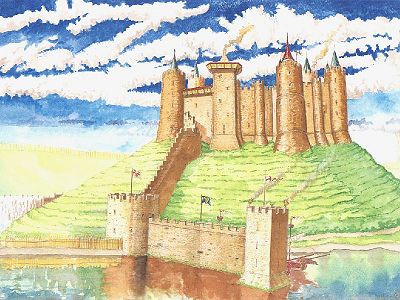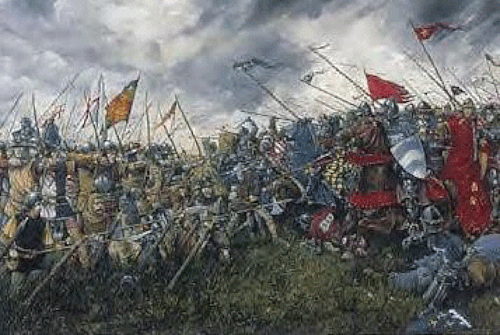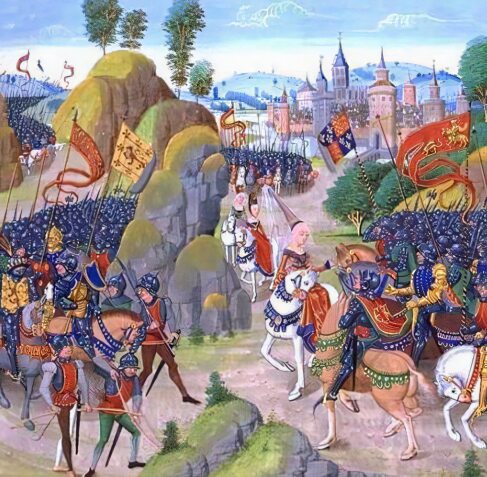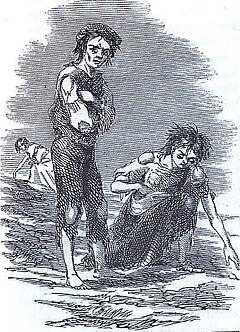 The Second War of Scottish Independence (1332 - 1357)
Old Grievances: Bailol II
The Second War of Scottish Independence (1332 - 1357)
Old Grievances: Bailol II
Originally chosen by Edward I as King of the Scots, John Bailiol had been forced to abdicate and now his son wanted revenge. He pressed Edward III, newly established as the actual power in England following the arrest of Mortimer, to restore to him his ancestral lands. Edward duly sent a request to the new king of Scotland, David II, the late Robert the Bruce’s son, but no reply came, so Edward said to Edward (yeah they were both Edwards - bloody English. And Scots!) “get in there and fill yer boots, son,” and Bailiol was not slow to accept the offer, marching into Scotland in 1332 where he met the forces of Donald, Earl of Mar. Well, when I say met…
See, our man Edward Balioil had gone to Scotland with a pretty piddling small army - about 1,500 - in the mistaken belief that he would be hailed as a saviour by the Scots and they would all flock to his banner. This failed to happen, and he even miscalculated by somehow offering Mar the chance to join him. The Earl, with about ten times as many men as the would-be usurper (or perhaps that should be
re-usurper, since his dad was king originally?) descended on them as they tried to get off their boats, fighting them, as a famous statesman would note six hundred years later, on the beaches. Nevertheless, despite the negligent size of their force, Bailiol fought Mar off, and the Scots legged it to Perth. Perth in Scotland that is, not Perth in Australia.
Also with Bailiol was the heir of the deposed Earl of Buchan, Henry Beaumont. Having helped themselves to weapons from a burgled Scottish armoury, they too proceeded to Perth where they faced off against the much larger Scottish force. Bad enough that it was - by some estimates - more than thirty times their size (though more likely ten, still a huge disparity), but that was only Mar’s lot. The lads commanded by the Earl of March (note that “ch” - not the same guy!) were already on their way, no doubt had they mobile phones they would have been texting Mar to “save sum 4 us!” So Bailiol and Beaumont knew they were in a pretty hopeless cause. The hoped-for Scottish support had not materialised, and here they were, standing against an army far larger than they had expected.
The Scots were so confident that they began to dance and get drunk, even before battle had been joined, but the English snuck into their camp that night and did for them. Sadly for Bailiol and his men, it was just a minor camp they had attacked, and when they saw in the morning that the main force of Mar’s army was still ready to engage them, they were, not to put too fine a point on it, more than a little upset. However it was, as it seems to have been down through history more often than not, disagreements among their commanders which undone the Scots.
Robert Bruce - another one; this one a bastard son of the dead king - saw the English crossing the river and immediately accused Mar of being in league with them. He had no doubt been aware of the overtures Bailiol had made to the earl with a view to joining him, and although Mar had declined the English commander’s kind invitation, Bruce was up in arms about it. Mar, for his part, told Bruce that far from being a traitor, he would prove how loyal he was by being the first to strike a blow against the enemy. Two can play at that game, thought Bruce, and, not to be outdone, charged his own schilltron at the English.
It was something of a mistake.
You see, what somebody should have told the young bastard is that if you ride too fast for everyone else to keep up with you, well, everyone can’t keep up with you. Consequently, his rather rash charge led to him leaving a lot of his men behind in the Scottish dust, which levelled the playing field a little between him and the English. However the Scots seem to have scorned wearing helmets, or at least visors, which was not a good idea when you’re facing a bunch of archers! Exposing their flank to the English as they charged, Bruce’s men, blinded by the arrows, began to veer closer together. Mar, of course, was not so hasty.
Um.
Well actually he did the same thing, coming up behind Bruce’s men and actually crashing into them in his haste. The English must have been rolling on the floor laughing, seven hundred years before the internet. The Scots, who had vastly outnumbered them at the outset, were doing their work for them! This extract from Wiki explains it all:
The struggle continued from a little past dawn until after noon. In the centre of the Scottish mass the result was literally suffocating; men were pressed too tightly together to be able to breathe and any who lost their footing were trampled to death. Contemporary accounts speak of more than a thousand Scots being smothered without coming into contact with the English. One claimed that "more were slain by the Scots themselves than by the English. For ... every one fallen there fell a second, and then a third fell, and those who were behind pressing forward and hastening to the fight, the whole army became a heap of the slain."
But an Englishman does not stand idly by and watch the enemy destroy himself, so in they waded, adding to the confusion, and it’s said they had to climb over heaps of dead Scots to get at the living ones. By evening it was all over. Bruce and Mar had both fallen, and the hugely superior army had been routed and had fled, leaving Bailiol and Beaumont to take Perth and fortify it as their base. Never in the field of human conflict had so few triumphed over so many with such hilarious results, maybe.
Despite having far fewer men, the English are reported to have lost less than a hundred while the number of deaths on the Scottish side vary in different accounts from two or three thousand to fifteen, though it can probably be accepted that that last one is an exaggeration. Nonetheless, the only surviving high-ranking Scot was the Earl of Fife, who was captured and changed his tune (sorry), going over to the English side. Guess he realised which side his haggis was buttered on. Sorry again.
Late for battle, the Earl of March turned up a week later, but by then the city of Perth was under Bailiol’s control and impregnable. Edward Bailiol was crowned King of Scotland on September 24 1332, but he would not have time to get comfortable on the throne, deposed by David II six months later. For the next four years he could arguably be called the yo-yo king, as he was on and off the throne more times than a man with chronic diarrhea. Edward III would finally take a personal hand in trying to subdue Scotland, and the second war for the country’s freedom would go on for another twenty-five years.
To some degree, what Bailiol had hoped for did come to pass, though kind of in retrospect, as with the defeat and death of Bruce and the Earl of Mar, many Scottish nobles did in fact swear their loyalty to him, as the new crowned king. Among these were Archibold Douglas, half-brother to the famous Black Douglas who had kept the high ground at Stanhope Park against Mortimer, and who was now Guardian of Scotland. Feeling he could let his guard down, now that this powerful former enemy was on his side, and perhaps rather foolishly, the new king dismissed most of his men, sent letters to Edward III proclaiming his subservience to him and Scotland’s to England (makes you wonder why they wanted an independent country in the first place if all they were going to do was stick their tongues down the back of Edward’s breeches, but however), promising to support him in his future wars.
Soon after, Douglas attacked. In concert with the Earl of Moray, Simon Fraser and, um, Robert II - who was King David’s nephew and next in line to the throne they took him so completely by surprise that the greater part of his men were wiped out and, in another slice of what I’m going to be calling hilarious history, Edward had to escape through a hole in the wall and ride to Carlisle buck naked! His brother Henry was killed, and so ended the Bailiol line of succession in Scotland, not that that would stop Edward making frequent visits to try on the crown a few times more.
 Invasion! V - The Return of the return of the kings: Edward, Edward and the Siege of Berwick
Invasion! V - The Return of the return of the kings: Edward, Edward and the Siege of Berwick
Long seen as the gateway to and from Scotland, Berwick had undergone major fortifications since it had been sacked in 1296, and was now in good shape to withstand a long siege, which was just as well, as that’s exactly what happened. Crossing over the border with Bailiol and other disgruntled Scottish nobles, Edward marched to cut Berwick off by land, as his navy had already done by sea. With him he brought people to build siege engines, and operated a scorched-earth policy to ensure that even if the siege were broken temporarily, no food would be available to the defenders. In his army was a man who had defended Berwick against the English, been captured and agreed to work for them; his knowledge of the castle and the town proved invaluable.
Catapults and trebuchets were used to great effect, and historians believe that Berwick had the dubious honour of being the first British town to be shelled by cannon fire. Hilarious history rears its humorous head again, as we learn that the defenders, hoping to burn the ships in the harbour blockading them, set alight driftwood soaked in tar, but instead managed to burn down most of the town! Oops!
The siege began at the start of May, by June the defenders had requested a temporary truce which, under perhaps the odd rules of chivalry, was granted, on the condition that Berwick had one month in which to be relieved, and if not they agreed to surrender. I suppose everyone needed a well-earned break. Meanwhile Douglas tried diversionary tactics, striking into England and taking the town of Tweedmouth, declaring to Edward III that if he did not withdraw his forces from Berwick he, Douglas, would devastate England. “Oh yeah?” the king probably didn’t reply, though he literally could have, “You and what army?” To which of course Douglas would have said “This one!”
But enough humour; war is a serious thing, and this siege was about to get even more serious.
In order to ensure the compliance of the Scots in the truce Edward had taken twelve hostages, including Thomas Seton, son of Sir Alexander, Governor of Berwick. When the Scots claimed they did not have to surrender, even though the named date had now passed, as Douglas was relieving them (though not exactly charging at Edward’s forces, it must be said) the king snapped back that no, that wasn’t how it was at all. Relief had to come from Scotland, from that side of the border, and Douglas had marched from England, so no deal. To reinforce his point, he had a gallows set up outside the gates of the town and hanged Thomas, promising that he would hang two more hostages every day until Berwick surrendered.
New and more specific terms for a potential surrender - with attendant promises of safe conduct for the defenders - were hammered out between the two parties, the defence of the town and the governorship having now passed to Sir William Keith. This time, however, only a four-day window was allowed.
I find it odd, I must say, when I read that the Scottish army under Douglas outnumbered the English by two-to-one that he didn’t attack them directly. Instead, he marched to Bamburgh, where the queen was staying, and laid siege to it, hoping to goad Edward into abandoning his position to save his damsel in distress. Not going to happen though. “She’s a big girl, and can take care of herself,” thought the king, and stayed where he was. Unable to take the town by force, Douglas realised he could no longer avoid battle (why was he trying to?) and headed off to meet Edward’s forces.
















 Linear Mode
Linear Mode
